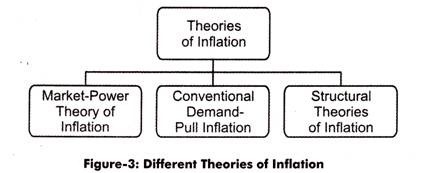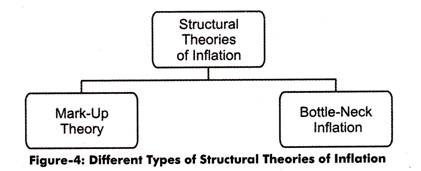Different economists have presented different theories on inflation. The economists who have provided the theories of inflation are broadly categorized into two labels, namely, monetarists and structuralists.
Monetarists associated inflation to the monetary causes and suggested monetary measures to control it.
On the other hand, structuralists believed that the inflation occurs because of the unbalanced economic system and they used both monetary and fiscal measures together for sorting out economic problems.
There are three main theories of inflation, which are shown in Figure-3:
Let us learn about the different theories of inflation (as shown in Figure-3) in detail.
Market-Power Theory of Inflation:
In an economy, when a single or a group of sellers together decide a new price that is different from the competitive price, then the price is termed as market-power price. Such groups keep prices at the level at which they can earn maximum profit without any concern for the purchasing power of consumers.
For example, in the past few years, the prices of onion were very- high in India. The soaring price of onions was the result of the group action of onion producers. In such a situation, people in middle and low income groups reduced the consumption of onions. However, onion producers earned high profits from higher income group.
ADVERTISEMENTS:
According to the advanced version of market power theory of inflation, oligopolists can increase the price to any level even if the demand does not rise. This hike in price levels occurs due to increase in wages (because of trade unions) in the oligopolistic industry.
The increase in wages is compensated with the hike in prices of products. With increase in the income of individuals, their purchasing power also increases, which further results in inflation.
Apart from this, some economists concluded that fiscal and monetary policies are not applicable in practical situations as these policies are not able to control rise in prices levels. These policies would work only when prices rise due to an increase in demand.
Moreover, these policies cannot be applied to oligopolistic rise in prices, which is due to increase in the cost of production. Monetary policy can reduce the rate of inflation by raising the interest rate and regulating the credit flow in the market. However, it would have no effect on the oligopolistic price as the cost is transferred to the prices of goods and services.
ADVERTISEMENTS:
Conventional Demand-Pull Inflation:
The market power theory of inflation represents one extreme end of inflation. According to this theory inflation exists even when there is no excess in demand. On the other end, the conventional demand-pull theorists believed that the only cause of inflation is the excess of aggregate demand over aggregate supply.
In full employment equilibrium condition, when demand increases, inflation becomes unavoidable. In addition in full employment condition, the economy reaches to its maximum production capacity. At this point, the supply of goods and services cannot be increased further while the demand of products and services increases rapidly. Due to this imbalance between demand and supply, inflation takes place in the economy.
Structural Theories of Inflation:
Apart from the two extreme ends mentioned in the above, there is a middle group of economists called structural economists. According to structural theory of inflation, market power is one of the factors that cause inflation, but it is not the only factor. The supporters of structural theories believed that the inflation arises due to structural maladjustments in the county or some of the institutional features of business environment.
They have provided two types of theories to explain the causes of inflation, which are shown in Figure-4:
Let us study the different types of structural theories of inflation (as shown in Figure-4) in detail in the next sections.
Mark-up Theory:
ADVERTISEMENTS:
Mark-up theory of inflation was proposed by Prof Gardner Ackley. According to him, inflation cannot occur alone by demand and cost factors, but it is the cumulative effect of demand-pull and cost-push activities. Demand-pull inflation refers to the inflation that occurs due to excess of aggregate demand, which further results in the increases in price level. The increase in prices levels stimulates production, but increases demand for factors of production. Consequently, the cost and price both increases.
In some cases, wages also increase without rise in the excess demand of products. This results in fall in supply at increased level of prices as to compensate the increase in wages with the prices of products. The shortage of products in the market would result in the further increase of prices.
Therefore, Prof. Gardner has provided a model of mark-up inflation in which both the factors, demand cost, are determined. Increase in demand results in the increase of prices of products as the customers spend more on products.
On the other the goods are sold to businesses instead of customers, then the cost of production increases. As a result, the prices of products also increase. Similarly, a rise in wages results in increase in cost of production, which would further increase the prices of products.
ADVERTISEMENTS:
So according to Prof Gardner, inflation occurs due to excess of demand or increases in wage rates; therefore, both monetary and fiscal policies should be used to control inflation. Though, these two policies are not adequate to control inflation.
Bottle-Neck Inflation:
Bottle-neck inflation was introduced by Prof Otto Eckstein. According to him, the direct relationship between wages and prices of products is the main cause of inflation. In other words, inflation takes place when there is a simultaneous increase in wages and prices of products. However, he believed that wage push or market-power theories alone are not able to provide a clear explanation of inflation.
After analysis of inflationary situation, Prof Eckstein says that the inflation occurs due to the boom in capital goods and wage-price spiral. In addition, he also advocated that during inflation prices in every industry is higher, but few industries show a very high price hike than rest of the industries.
ADVERTISEMENTS:
These industries are termed as bottle-neck industries, which are responsible for increase in prices of goods and services. In addition, Prof. Eckstein advocated that concentration of demand for products of bottle industries results in inflation.

